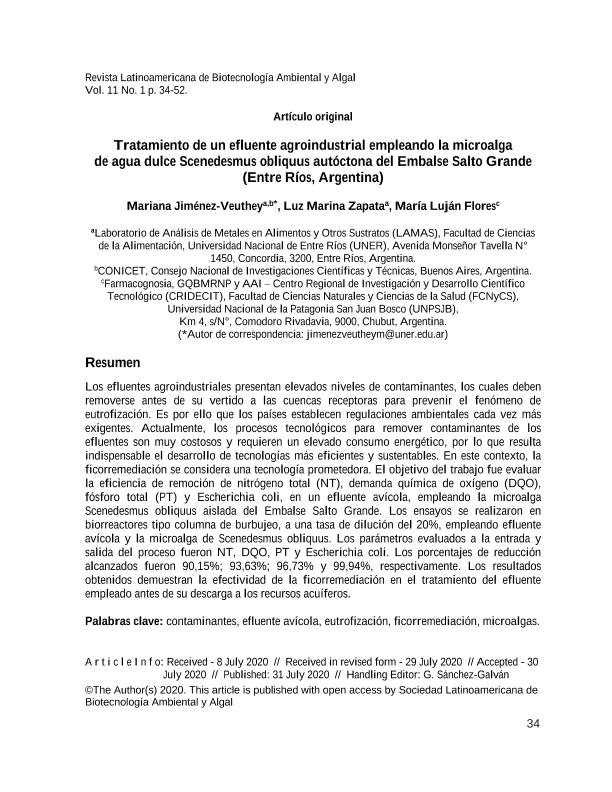Artículo
Los efluentes agroindustriales presentan elevados niveles de contaminantes, los cuales deben removerse antes de su vertido a las cuencas receptoras para prevenir el fenómeno de eutrofización. Es por ello que los países establecen regulaciones ambientales cada vez más exigentes. Actualmente, los procesos tecnológicos para remover contaminantes de los efluentes son muy costosos y requieren un elevado consumo energético, por lo que resulta indispensable el desarrollo de tecnologías más eficientes y sustentables. En este contexto, la ficorremediación se considera una tecnología prometedora. El objetivo del trabajo fue evaluar la eficiencia de remoción de nitrógeno total (NT), demanda química de oxígeno (DQO), fósforo total (PT) y Escherichia coli, en un efluente avícola, empleando la microalga Scenedesmus obliquus aislada del Embalse Salto Grande. Los ensayos se realizaron en biorreactores tipo columna de burbujeo, a una tasa de dilución del 20%, empleando efluente avícola y la microalga de Scenedesmus obliquus. Los parámetros evaluados a la entrada y salida del proceso fueron NT, DQO, PT y Escherichia coli. Los porcentajes de reducción alcanzados fueron 90,15%; 93,63%; 96,73% y 99,94%, respectivamente. Los resultados obtenidos demuestran la efectividad de la ficorremediación en el tratamiento del efluente empleado antes de su descarga a los recursos acuíferos. Agroindustrial effluents have high levels of contaminants, which must be removed before being discharged into the receiving basins to avoid the phenomenon of eutrophication. That is why countries establish increasingly stringent environmental regulations. Currently, technological processes to remove contaminants from effluents are very expensive and require high energy consumption; therefore, the development of more efficient and sustainable technologies is essential. In this context, phycoremediation is considered a promising technology. The aim of the work was to evaluate the removal efficiency, in poultry effluents, of total nitrogen (TN), chemical oxygen demand (COD), total phosphorus (TP) and Escherichia coli using Scenedesmus obliquus microalgae isolated from the Reservoir Salto Grande. The assays were carried out in bubble column type bioreactors, at dilution rate of 20%, using poultry effluent and Scenedesmus obliquus microalga. The parameters evaluated at the inlet and at the outlet streams of the process were TN, COD, TP and Escherichia coli. The reduction percentages achieved were 90.15%; 93.63%; 96.73% and 99.94%, respectively. The results obtained demonstrate the effectiveness of the phytoremediation in the treatment of the effluent used before its discharge in acoustic resources.
Tratamiento de un efluente agroindustrial empleando la microalga de agua dulce Scenedesmus obliquus autóctona del Embalse Salto Grande (Entre Ríos, Argentina)
Título:
Treatment of an agro-industrial effluent using the native freshwater microalgae Scenedesmus obliquus from the Salto Grande Reservoir (Entre Ríos, Argentina)
Fecha de publicación:
07/2020
Editorial:
Sociedad Latinoamericana de Biotecnología Ambiental y Algal
Revista:
Revista Latinoamericana de Biotecnología Ambiental y Algal
ISSN:
2007-2570
Idioma:
Español
Tipo de recurso:
Artículo publicado
Clasificación temática:
Resumen
Palabras clave:
CONTAMINANTES
,
EFLUENTE AVÍCOLA
,
EUTROFIZACIÓN
,
FICORREMEDIACIÓN
,
MICROALGAS
Archivos asociados
Licencia
Identificadores
Colecciones
Articulos (ICTAER)
Articulos de INSTITUTO DE CIENCIA Y TECNOLOGIA DE LOS ALIMENTOS DE ENTRE RIOS
Articulos de INSTITUTO DE CIENCIA Y TECNOLOGIA DE LOS ALIMENTOS DE ENTRE RIOS
Citación
Jimenez Veuthey, Mariana; Zapata, Luz Marina; Flores, Maria Lujan; Tratamiento de un efluente agroindustrial empleando la microalga de agua dulce Scenedesmus obliquus autóctona del Embalse Salto Grande (Entre Ríos, Argentina); Sociedad Latinoamericana de Biotecnología Ambiental y Algal; Revista Latinoamericana de Biotecnología Ambiental y Algal; 11; 1; 7-2020; 34-52
Compartir




